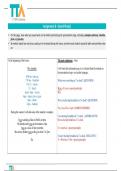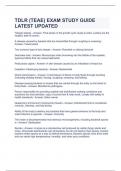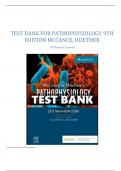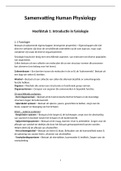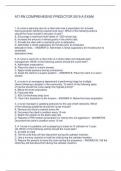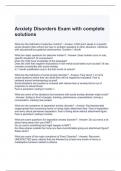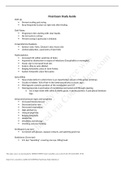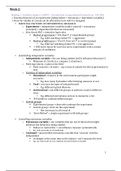Samenvatting ABG
[LECTURE] Chapter 2 Hardy Weinberg Equilibrium
Deviations:
It can happen that the number of observed
heterozygotes deviates strongly from the
expected (see picture, -288 is the difference in
expected vs observed), can be due to many
reasons:
- Non-random / biased sampling.
- Maybe you are accidentally sampling
multiple populations together rather
than 1 pouplation. Sampling is not from a
single population: Wahlund effect.
o Df = degrees of freedom.
▪ = Number of classes of data (number of genotypes e.g. AA, Aa & aa =
3
o – minus number of parameters estimated from data (p & q,
but when you know p, you also know q, so we only really
estimate 1 parameter from the data)
o – minus 1 (I don’t know why, not explained, just -1)
▪ Chi-square test = to test if a population is at HW equilibrium:
▪ X^2 = ∑(Observed – expected)^2/expected.
o Hypothesis is that population is in Hardy Weinberg equilibrium
o Look up DF in the table
o If Chi-square is larger than critical value from DF table -> reject null
hypothesis
▪ Thus population is NOT in HW equilibrium
,• Evolution always involves a change in allele frequencies.
• Genetic variation through recombination and mutation processes.
• Mutations provide genetic variation for natural selection to act on.
• Point mutation:
o Base pair substitution.
o Creates new alleles.
• Chromosome inversion:
o Flipping of a chromosome segment.
o Alleles inside the inversion are likely to be transmitted together.
• Gene duplication:
o Duplication of a short stretch of DNA, creating an extra copy of the sequence.
o Redundant new genes may acquire new functions.
• Genome duplication:
o Addition of a complete set of chromosomes.
o May create new species.
• Any change in genome.
• Random with respect to their effect on fitness: is does not appear in a higher
frequency in an environment where it provides a benefit to its bearer.
• Most mutations are deleterious or neutral.
• Most have a small phenotypic effect.
• Fitness effects:
o Midly deleterious.
o Some are strongly deleterious, neutral or beneficial.
o Deleterious will be eliminated by natural selection.
o Mutation selection balance.
,[LECTURE] Chapter: Molecular Markers
It’s all about variation, differences in phenotype are considered
phenotypic variation, which is the result of genomic variation.
The basis for this genomic variation lies in the DNA, which is
both located in the nucleus and in the mitochondrial DNA.
There are chromosomes in the nucleus, both autosomes and
sex-chromosomes. In order to monitor genetic variation, it is
necessary to sequence the genome, so where are the genes
located and how are they different? But it’s not only the level
of genes, it is also on a regulatory level, so promotors,
transcription factors and the way in which the DNA is winded
up in the chromosomes.
Autosomal recessive inheritance: both parents carry one copy of the same mutant gene, so
that each of their children has ¼ chance of inheriting two copies of disease-linked genes.
Autosomal dominant inheritance: parents also infection and give ½ chance to children of
inheriting.
X-linked recessive pattern: Mutant gene is on the X chromosome so that female children are
carrier, but male children are affected.
,Mitochondrial DNA -mtDNA is inherited maternally, so offspring will always have the mtDNA
from the mother. It contains 16.000 – 18.000 basepairs and has several genes which can be
used for taxonomy and phylogeny.
There are different ways of analyzing the mithochondrial DNA:
- Either a part (often the D-loop = 800bp) or the whole
mtDNA (16k bp) can be sequenced, but the latter is
quite costly. Mostly a part of it is sequenced.
- There are more copies of mtDNA in a cell and it is the
exact same in all cells, because it is very much
conserved. That enables the use of mtDNA in ancient
phylogeny, as it has a very low mutation rate. This is
also because the circular configuration of the DNA is
much more stable than the linear DNA in our
chromosomes.
- After sequencing, a SNP assay is done to compare the mtDNA sequences of
individuals or species based on single nucleotide polymorphisms
- These differences can be used to build a phylogenetic tree, but important to not that
these trees can give a rough idea of the direction of evolution, but it will not always
be 100% correct answer and can change with new discoveries
Autosomes and sex-chromosomes are inherited
50% from the father and 50% from the mother.
Depending on species how many chromosome
pairs are present in the nucleus.
The way in which gender is determined also differs
upon species, humans have the X,Y system, other
species might have Z,W where homozygotes (ZZ)
are actually the males.
The sex differentiation over time has thus changed
due to breakage of chromosomes, some genes
have been displaced to other chromosomes.
,All variation in genes and thus genotypes and
phenotypes is based on mutations. These can
be single nucleotide polymorphisms:
insertion, deletion or nucleotide change from
e.g. A to C or G to A.
There can also be larger indels added or parts
of the genes deleted from chromosomes.
Deletions or additions of 1 or more
nucleotides can result in a shift in open
reading frame if the insertion or deletion is
not a multiple of 3.
Mutations, deletions or insertions not always
have a negative effect, for examle it will not
cause a problem e.g. if it happens in an intron.
STR’s are Short repetitive sequences that will
be repeated in many copies at a certain
position.
Some SNP mutations happen more often
than others, transitions are changes between
A – G or C – T. Transversions occur less often.
Such SNP’s can change a codon to another
amino acid, changing the proteins and thus
it’s function.
An SNP is bi-allelic so 1 mutation will give you 1 different nucleotide, so only one change.
Several marker systems to detect changes and compare different sequences:
Single nucleotide polymorphisms: PCR-SSCP, PCR-RFLP
- Fairly simple, you isolate the DNA, PCR it with the right primers, sequence it and use
the sequences in a BLAST or other programme to compare different sequences and
find the SNP’s.
Microsatellite markers (SSR, micro’s) (multi-allelic)
- Sometimes there are Short Sequence Repeats (SSR’s) on
a chromosome, of which the number of repeats can vary
between individuals and between the chromosomes in a
pair. These repeats have specific flanking regions, which
can be used to design primers and by running the
product on a gel, you can see if there are differences in
size -> differences in number of repeats.
- In example on the right something strange, four peaks in
lane 1, where you would expect 2 (2 chromosomes), but sometimes the PCR makes
mistakes and recognizes e.g. 9 repeats instead of 10. So it shows some smaller peaks
/ lighter bands that are not representative of real microsatellite analysis.
, Copy number varation (CNV) (Multi-allelic)
Copy number variation is a structural
variation where either a large part of the
DNA is deleted, a new part is inserted, a
part is switched with another
chromosome, inverted or displaced.
Usually we focus on inversion and
translocation. Basically what happens
with a deletion, the chromosome
becomes smaller, with an insertion the
chromosome becomes longer. So a large
part of the DNA including several genes
can be translocated to other parts or
completely different chromosomes. Can
have direct influence on genes or e.g. the transcription of these parts that are now under
different expression factors or might now not be part of active DNA anymore.
[LECTURE] Chapter 2 Hardy Weinberg Equilibrium
Deviations:
It can happen that the number of observed
heterozygotes deviates strongly from the
expected (see picture, -288 is the difference in
expected vs observed), can be due to many
reasons:
- Non-random / biased sampling.
- Maybe you are accidentally sampling
multiple populations together rather
than 1 pouplation. Sampling is not from a
single population: Wahlund effect.
o Df = degrees of freedom.
▪ = Number of classes of data (number of genotypes e.g. AA, Aa & aa =
3
o – minus number of parameters estimated from data (p & q,
but when you know p, you also know q, so we only really
estimate 1 parameter from the data)
o – minus 1 (I don’t know why, not explained, just -1)
▪ Chi-square test = to test if a population is at HW equilibrium:
▪ X^2 = ∑(Observed – expected)^2/expected.
o Hypothesis is that population is in Hardy Weinberg equilibrium
o Look up DF in the table
o If Chi-square is larger than critical value from DF table -> reject null
hypothesis
▪ Thus population is NOT in HW equilibrium
,• Evolution always involves a change in allele frequencies.
• Genetic variation through recombination and mutation processes.
• Mutations provide genetic variation for natural selection to act on.
• Point mutation:
o Base pair substitution.
o Creates new alleles.
• Chromosome inversion:
o Flipping of a chromosome segment.
o Alleles inside the inversion are likely to be transmitted together.
• Gene duplication:
o Duplication of a short stretch of DNA, creating an extra copy of the sequence.
o Redundant new genes may acquire new functions.
• Genome duplication:
o Addition of a complete set of chromosomes.
o May create new species.
• Any change in genome.
• Random with respect to their effect on fitness: is does not appear in a higher
frequency in an environment where it provides a benefit to its bearer.
• Most mutations are deleterious or neutral.
• Most have a small phenotypic effect.
• Fitness effects:
o Midly deleterious.
o Some are strongly deleterious, neutral or beneficial.
o Deleterious will be eliminated by natural selection.
o Mutation selection balance.
,[LECTURE] Chapter: Molecular Markers
It’s all about variation, differences in phenotype are considered
phenotypic variation, which is the result of genomic variation.
The basis for this genomic variation lies in the DNA, which is
both located in the nucleus and in the mitochondrial DNA.
There are chromosomes in the nucleus, both autosomes and
sex-chromosomes. In order to monitor genetic variation, it is
necessary to sequence the genome, so where are the genes
located and how are they different? But it’s not only the level
of genes, it is also on a regulatory level, so promotors,
transcription factors and the way in which the DNA is winded
up in the chromosomes.
Autosomal recessive inheritance: both parents carry one copy of the same mutant gene, so
that each of their children has ¼ chance of inheriting two copies of disease-linked genes.
Autosomal dominant inheritance: parents also infection and give ½ chance to children of
inheriting.
X-linked recessive pattern: Mutant gene is on the X chromosome so that female children are
carrier, but male children are affected.
,Mitochondrial DNA -mtDNA is inherited maternally, so offspring will always have the mtDNA
from the mother. It contains 16.000 – 18.000 basepairs and has several genes which can be
used for taxonomy and phylogeny.
There are different ways of analyzing the mithochondrial DNA:
- Either a part (often the D-loop = 800bp) or the whole
mtDNA (16k bp) can be sequenced, but the latter is
quite costly. Mostly a part of it is sequenced.
- There are more copies of mtDNA in a cell and it is the
exact same in all cells, because it is very much
conserved. That enables the use of mtDNA in ancient
phylogeny, as it has a very low mutation rate. This is
also because the circular configuration of the DNA is
much more stable than the linear DNA in our
chromosomes.
- After sequencing, a SNP assay is done to compare the mtDNA sequences of
individuals or species based on single nucleotide polymorphisms
- These differences can be used to build a phylogenetic tree, but important to not that
these trees can give a rough idea of the direction of evolution, but it will not always
be 100% correct answer and can change with new discoveries
Autosomes and sex-chromosomes are inherited
50% from the father and 50% from the mother.
Depending on species how many chromosome
pairs are present in the nucleus.
The way in which gender is determined also differs
upon species, humans have the X,Y system, other
species might have Z,W where homozygotes (ZZ)
are actually the males.
The sex differentiation over time has thus changed
due to breakage of chromosomes, some genes
have been displaced to other chromosomes.
,All variation in genes and thus genotypes and
phenotypes is based on mutations. These can
be single nucleotide polymorphisms:
insertion, deletion or nucleotide change from
e.g. A to C or G to A.
There can also be larger indels added or parts
of the genes deleted from chromosomes.
Deletions or additions of 1 or more
nucleotides can result in a shift in open
reading frame if the insertion or deletion is
not a multiple of 3.
Mutations, deletions or insertions not always
have a negative effect, for examle it will not
cause a problem e.g. if it happens in an intron.
STR’s are Short repetitive sequences that will
be repeated in many copies at a certain
position.
Some SNP mutations happen more often
than others, transitions are changes between
A – G or C – T. Transversions occur less often.
Such SNP’s can change a codon to another
amino acid, changing the proteins and thus
it’s function.
An SNP is bi-allelic so 1 mutation will give you 1 different nucleotide, so only one change.
Several marker systems to detect changes and compare different sequences:
Single nucleotide polymorphisms: PCR-SSCP, PCR-RFLP
- Fairly simple, you isolate the DNA, PCR it with the right primers, sequence it and use
the sequences in a BLAST or other programme to compare different sequences and
find the SNP’s.
Microsatellite markers (SSR, micro’s) (multi-allelic)
- Sometimes there are Short Sequence Repeats (SSR’s) on
a chromosome, of which the number of repeats can vary
between individuals and between the chromosomes in a
pair. These repeats have specific flanking regions, which
can be used to design primers and by running the
product on a gel, you can see if there are differences in
size -> differences in number of repeats.
- In example on the right something strange, four peaks in
lane 1, where you would expect 2 (2 chromosomes), but sometimes the PCR makes
mistakes and recognizes e.g. 9 repeats instead of 10. So it shows some smaller peaks
/ lighter bands that are not representative of real microsatellite analysis.
, Copy number varation (CNV) (Multi-allelic)
Copy number variation is a structural
variation where either a large part of the
DNA is deleted, a new part is inserted, a
part is switched with another
chromosome, inverted or displaced.
Usually we focus on inversion and
translocation. Basically what happens
with a deletion, the chromosome
becomes smaller, with an insertion the
chromosome becomes longer. So a large
part of the DNA including several genes
can be translocated to other parts or
completely different chromosomes. Can
have direct influence on genes or e.g. the transcription of these parts that are now under
different expression factors or might now not be part of active DNA anymore.

